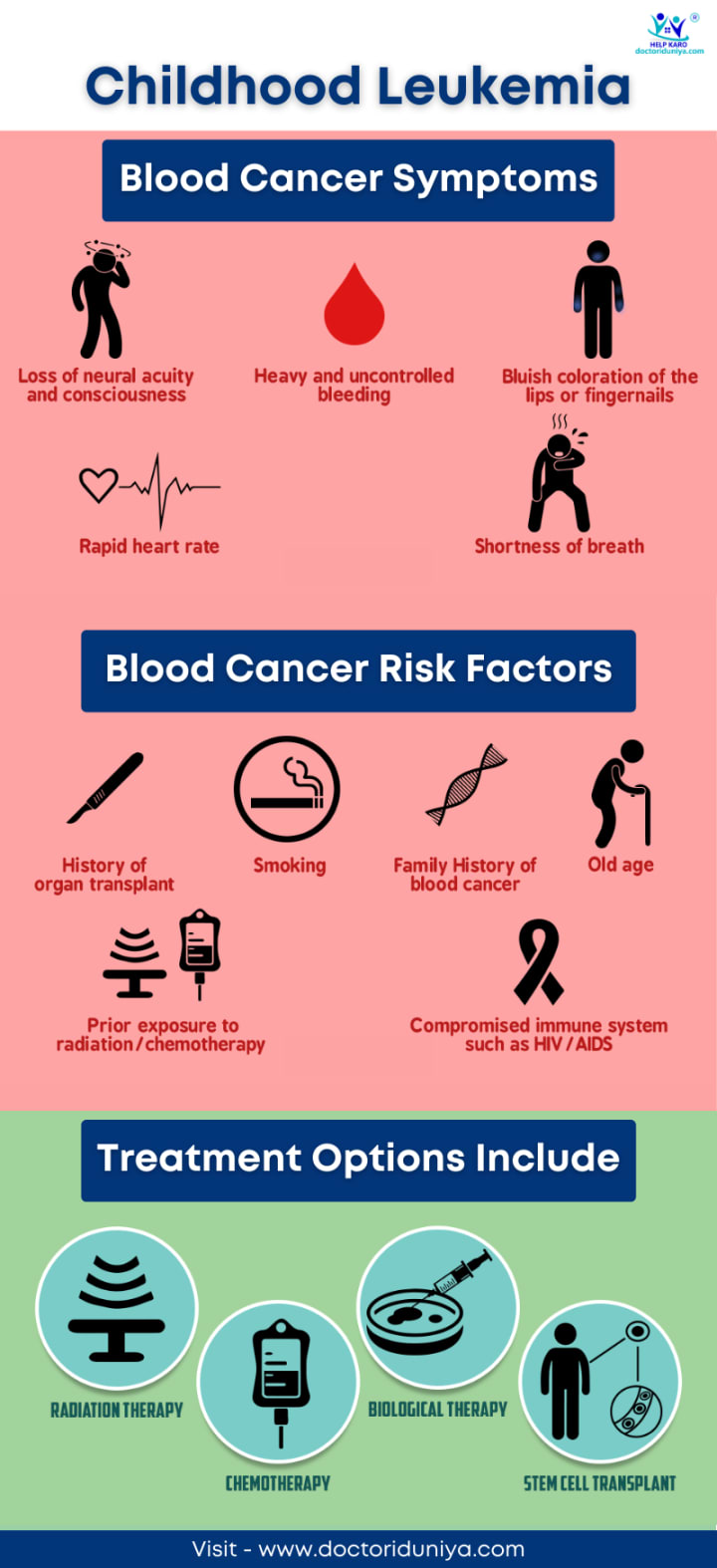
Leukemia — Cancer of blood is called Leukemia. It develops in the bone marrow. Bone marrow is a soft inner part of the bone (such as thigh and hip bone) where new RBC, WBC & Platelets are formed.
As we know, bone marrow also produces WBC or Leucocytes. As soon as the number of mature WBC is enough, then the body sends a signal to stop new cells’ formation. But in Leukemia, these newly formed cells stay immature for a long time. Consequently, the body cannot send any signal, so new cells form inside the bone marrow. The bone marrow becomes crowded with immature and abnormal WBC.
Childhood Leukemia — Children of the age group of a newborn child to a 19-year-old. According to a study conducted in 2018, 29% of cancer in children is of childhood leukemia. The most common Leukemia in children is ALL (Acute Lymphoblastic Leukemia) and AML (Acute myeloid leukemia).
Early Symptoms of Childhood Leukemia
a. Dull or pale skin
b. Weakness or feeling of tiredness
c. Headaches and Dizziness
d. Trouble in breathing
e. Fever and frequent infection
f. Bleeding gums or nosebleeds
Types of Childhood Leukemia: Leukemia typically in kids can be categorized into two major types.
A. Common types of Leukemia
a. Acute lymphoblastic Leukemia (ALL), also called acute lymphocytic Leukemia is fast-growing Leukemia of lymphoid cells. This type is widespread in kids; it’s the proliferation of B and T cells lymphocyte precursor. Acute Lymphoblastic Leukemia (ALL) accounts for 75–85% of cases of childhood leukemia.
b. Acute Myelogenous Leukemia (AML): AML is also a common type of childhood leukemia. This is the fast-growing Leukemia of myeloid cells.
B. Rare types of Leukemia
a. Hybrid or mixed-lineage Leukemia: This is chromosome-related Leukemia where part of chromosome 11 translocates to any other chromosome. Children having mixed-lineage Leukemia have a poor prognosis.
b. Chronic Myelogenous Leukemia: This is slow-growing Leukemia of myeloid cells.
c. Chronic lymphocytic Leukemia (CLL): CLL is very rare in children. This is the slow-growing Leukemia of lymphoid cells.
d. Juvenile myelomonocytic Leukemia (JMML): This is a scarce type of childhood leukemia where WBC production in bone marrow is severely dysregulated.
Diagnosis of Childhood Leukemia
There are various tests to diagnose and confirm childhood leukemia. These tests also help in classifying the type of Leukemia.
The initial tests include:
a) Blood tests to measure the number of blood cells and see how they appear.
b) Biopsy and Bone marrow aspiration test: To confirm Leukemia, a tissue sample is usually taken from the pelvic bone.
c) Spinal Tap test or Lumbar puncture: This test is done to know the spread of cancer cells in the fluid (cerebrospinal fluid) present in the spinal cord or brain.
These tests also determine the method of treatment to be followed.
Risk factors of Childhood Leukemia
More study is needed to explore the possible reasons, but few of them are environmental factors like exposure to radiation, smoking, genetic factors, inherited problems related to immune systems, etc.

Treatment of Childhood Leukemia:
Once the oncologist confirms the diagnosis, the child will undergo chemotherapy medicines. In highly developed countries, the cure rate for ALL (Acute lymphoblastic leukemia) is more than 80–90%, and for acute myeloid Leukemia, it is more than 60–70%. In developing countries, poor accessibility or affordability, malnutrition, poor tolerability to treatment, and delayed diagnosis bring down the cure rate to almost 70% in ALL and around 50% in AML.
a) Chemotherapy: Chemotherapy uses powerful chemicals and is done to target and kill cancerous cells. Chemotherapy works throughout the body.
b) Blood Transfusion: This is a process of transferring healthy blood components into a patient’s blood circulation system intravenously. This process helps in replacing red blood cells, platelets, and other blood components.
c) Radiation Therapy: This is also known as Radiotherapy or RT or XRT. This therapy uses a beam of ionizing radiation to kill the cancer cells.
d) Bone Marrow Transplant: BMT is performed to replace damaged or destroyed bone marrow. In this process, blood stem cells are transplanted into the circulation. Later on, these blood stem cells reach the bone marrow area to produce and promote new blood cells.
Treatment of Relapsing Leukemia
Despite chemotherapy, around 20% of ALL and about 40–50% of AML can come back with the disease within two to five years of initial diagnosis. This reoccurrence of infection is called relapse. Again, these children will go through a similar test like complete blood count, bone marrow evaluation to confirm the deterioration. After confirmation, they will have to undergo a higher dose of chemotherapy of a different combination or Bone Marrow Transplant.
You can consult a well-experienced oncologist, or you can consult online on consultancy websites like Practo, DoctoriDuniya, etc. At DoctoriDuniya, You can book an appointment online with an oncologist or cancer specialist 24X7, with eOPd and an e-prescription facility.
The cancer doctor may ask about the family history of the problem and symptoms associated with the disease.
At DoctoriDuniya, you can download DoctoriDuniya — Free Medical App and create your online Personal Medical Account called NAINI. Here you can avail free follow-ups and online doctor consultation with oncologist or cancer specialist at NAINI.
About the Creator
Matt Hank
Hello, It's Matt Hank here






Comments
There are no comments for this story
Be the first to respond and start the conversation.